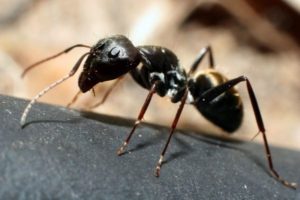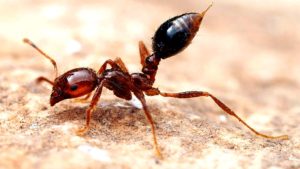ANTS
Scientific Name: Formicidae
Ants are generally more of a nuisance than a danger, though they can sting and a few can bite. bodrum airport transfers Different species of ant sting with a range of chemicals, including formic acid, alkaloids and piperidines.
Ants can invade homes, other buildings, and gardens to forage for food and build nests. Out of the thousands of species of ant worldwide, there are only a few ant species that are regarded as pests in each country.
How Did I Get Ants?
Poor sanitation is the primary cause of ant infestations. Leaving dirty dishes in the sink, food residue on countertops, crumbs on the floor and trash not frequently emptied provide food sources for meal-seeking ants. What starts with a few foragers entering a home can become a major problem if ants establish colonies in walls, lawns, or under home foundations.
How Serious Are Ants?
One of the biggest problems related to ants in the home is food contamination. Ants carry bacteria on their bodies, which spreads when they crawl in pantries and across countertops. Only a few species are known to transmit diseases, but finding any type of ant in pantry goods or inside the home is an unpleasant experience that creates nuisances.Some species, like carpenter and fire ants, cause additional problems. A carpenter ant infestation can do costly damage by chewing tunnels through wood beams. Fire ant stings that involve envenomation can cause pain and more serious symptoms that often result in allergic reactions to some people who are hyper-sensitive to ant stings
Different Ant species
Little Black Ant
Scientific Name: Monomorium minimum
Appearance:
- This is very small (1/15 in. long)
- Shiny black body color.
- The workers about 1 to 2 mm long.
- Queens 4 to 5 mm long.
- A monomorphic species, with only one caste of worker, and polygyne
Lifecycle:
- Little black ant colonies have multiple queens and may become very large.
Habits
- Nests are normally located outdoors, in the soil and in relatively open areas, or under objects.
- These ants will also nest in rotten wood, woodwork and the masonry of buildings.
- Most of their feeding is on plant secretions or honeydew of aphids and scale insects, but occasionally invade houses in search of food.
- Once inside, they feed on sweets, meats, breads, grease, vegetables and fruit.
Garden Ant
Scientific Name: Lasiusniger
Appearance
- Workers 4-5mm long.
- Queens 15mm long.
- Dark brown-black in colour.
- 1 small segment at waist point (pedicel).
- No sting present.
Lifecycle
- Queens overwinter in soil. Eggs are laid in late spring.
- Larvae hatch 3-4 weeks later.
- Larvae feed on secretions from the queen’s salivary glands until the first worker ants emerge.
- Worker ants continue with larval care, nest building and food foraging.
- Fertile males are produced later in the season.
Habits
- Foraging worker ants follow well–defined trails around food sources. Sweet foods are preferred but high protein foods will also be taken.
- Swarming characteristics – mating between queens and fertile males takes place on the wing mid to late summer. Males perish after mating.
- Nest locations – often outdoors in soil and below paving slabs on the sunny side of buildings.
- Nest locations can be identified by the presence of finely powdered soil around nest exit holes.
Fire Ant
Scientific Name: Solenopsisspp
Appearance
- Queens 5/8″ long.
- Workers 1/8″-1/4″ long.
- Coppery–brown on the head and body, with a darker abdomen.
- Solenopsis has a very distinctive two–segment antennal club, which is most visible in the front view of the female reproductive ant.
Lifecycle
- After swarming from the nest and mating, the queen searches for a suitable spot to lay her eggs. Once found, she can lay up to 125 eggs in late Spring.
- Larvae hatch within 8 to 10 days, and the pupal stage lasts for 9 to 16 days.
- Larvae feed on secretions from the queen’s salivary glands and broken down wing muscles until the first worker ants emerge. After this first batch of larvae moult into workers the queen’s role returns to egg laying – she can lay up to 1500 per day. Worker ants continue with larval care, nest building and food foraging.
- Fertile males are produced later in the season.
Habit
- Foraging workers diet consists of dead animals, including insects, earthworms, and vertebrates. Workers also collect honeydew and forage for sweet food, proteins, and fats.
- Nest locations can be a mound of up to 40 cm or next to objects found on the ground, e.g. logs.
- If aggravated, these react aggressively and can inflict a painful sting, resulting in a pustule some 48 hours later.
- These ants are a major agricultural and urban pest, destroying crops and invading residential areas both outdoors and indoors.
Pharaoh’s Ant
Scientific Name: Monomoriumpharaonis
Appearance:
- Workers 1.5-2mm long, yellow-brown with brown abdomen.
- Males 3mm long, black, winged.
- Queens 3.5-6mm long, dark red in colour with wings.
- Black eyes, 2 small segments at the pedicel.
Lifecycle:
- Multi-queen colonies.
- Swarming can take place at any time of the year.
- Winged adults seldom fly so rarely seen. Wings are soon lost after mating.
Habits:
- Well–defined trails are laid which are often associated with heating systems. Feeds indoors on high protein foods — meat, fats, blood, dead insects, etc.
- Swarming characteristics — new colonies are often formed through nests that have been disturbed e.g., as a result of insecticide spray treatments.
- Each queen produces up to 3500 eggs in its lifetime.
- Nest locations — deep seated in cavities in heated buildings. Often found in hospitals. Associated with humid conditions. Colonies can range from a few dozen to 300,000 individuals.
Ghost Ants
Scientific Name:Tapinomamelanocephalum
Appearance:
- Pale/Translucent legs and abdomen.
- Approx 1.6mm long.
Lifecycle
- Continuous breeding colonies.
Habits
- Feeding – indoors: sweet substances and grease; outdoors: insects that produce honeydew.
- Nesting – indoors: small spaces, wall voids; outdoors: in flowerpots, under objects on the ground, under loose bark.
- Locations – attracted to high moisture areas, can be found in kitchen and bathroom cabinets.
- Colonies can occupy several different nesting sites.
Pavement Ants
Scientific Name: Tetramoriumcaespitum
Appearance:
- Dark brown or blackish.
- Approx 3mm long.
- 6 legs.
- 2 spines on the back.
- 2 nodes on petiole.
- Grooves on head and thorax.
- Thorax uneven with 1 pair of spines.
- 12-segmented antennae with 3-segmented club.
- Winged ants are often mistaken for termites.
Lifecycle:
- Visible spring and summer.
- Have been known to emerge any time of the year in heated structures.
Habits:
- Feeding – eat almost anything that humans eat, and also pet food.
- Visibility – seen entering houses looking for food, most often at night. May move through pipes and electrical wires.
- Nesting – in lawns or under stones, wood, or boards. Mounds built along sidewalks, baseboards, and near foundations in clusters.
- Colonies found near water.